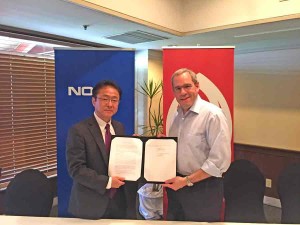Docomo Pacific signs a deal with Nokia on Atisa

Docomo Pacific president and CEO Jonathan Kriege, right, and Nokia Japan head Masatoshi Nishihara show off their newly signed memorandum of understanding. (Contributed Photo)
Docomo Pacific and Nokia Japan signed a memorandum of understanding yesterday for a three-year joint partnership on Atisa, the CNMI’s second undersea fiber-optic cable.
Docomo Pacific president and CEO Jonathan Kriegel signed the memorandum with Nokia Japan’s Masatoshi Nishihara.
Kriegel also announced that the Atisa optical submarine cable system will be launched on June 1, 2017.
“With Atisa, Docomo will bring better indoor and outdoor coverage, faster speed, expand the number of television channels to about 200, bring access to pay-preview, video on demand, and provide carrier Wi-Fi (Wi-Fi hotspots) to certain areas of the island and more,” Kriegel said.
Docomo Pacific will also increase the number of cell sites on Saipan, Tinian, and Rota.
Saipan currently has 31 cell sites. This will grow to 36 cell sites. Out of the 36, 20 will be at LTE speed.
LTE stands for Long-Term Evolution and is a standard for high-speed wireless communication network.
Under Docomo Pacific’s plan, Tinian will go from one cell site to three, with all three on LTE. Rota currently has two cell sites; that will double to four and all will be LTE as well.
From an economic standpoint, “Atisa will open doors to data usage stimulation growth and encourage private sector investments through tourism, hotels, and other industries,” Kriegel said.
In addition, Atisa will connect the CNMI and Guam to a single line market where it acts as a regular landline call.
Nishihara said, “What we need to do to go further is to change our relationship into a strategic business partnership.”
Nokia has a longstanding relationship with Docomo, which dates back to the successful launch of 3G services in Guam in 2008, followed by the rollout of LTE in 2012.
“This is a state-of-the art, multimillion-dollar network that will transform enterprises today and for future innovative services through telemedicine, education, and security,” Kriegel said.
The CNMI’s lone undersea fiber-optic cable is owned by IT&E. (Demalyn S. Pagarao)



























